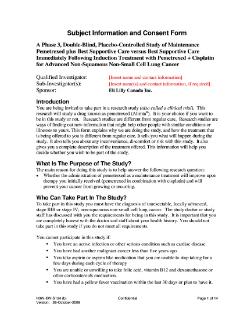The Emergency Medical Treatment and Active Labor Act (EMTALA) is an act of the United States Congress, passed in 1986 as part of the Consolidated Omnibus Budget Reconciliation Act (COBRA). It requires hospital Emergency Departments that accept payments from Medicare to provide an appropriate medical screening examination (MSE) to anyone seeking treatment for a medical condition, regardless of citizenship, legal status, or ability to pay. Participating hospitals may not transfer or discharge patients needing emergency treatment except with the informed consent or stabilization of the patient or when their condition requires transfer to a hospital better equipped to administer the treatment.

Informed consent is a process for getting permission before conducting a healthcare intervention on a person, or for disclosing personal information. A health care provider may ask a patient to consent to receive therapy before providing it, or a clinical researcher may ask a research participant before enrolling that person into a clinical trial. Informed consent is collected according to guidelines from the fields of medical ethics and research ethics.
A patient's bill of rights is a list of guarantees for those receiving medical care. It may take the form of a law or a non-binding declaration. Typically a patient's bill of rights guarantees patients information, fair treatment, and autonomy over medical decisions, among other rights.

An emergency department (ED), also known as an accident & emergency department (A&E), emergency room (ER), emergency ward (EW) or casualty department, is a medical treatment facility specializing in emergency medicine, the acute care of patients who present without prior appointment; either by their own means or by that of an ambulance. The emergency department is usually found in a hospital or other primary care centre.

Tuskegee Study of Untreated Syphilis in the Negro Male was a clinical study conducted between 1932 and 1972 by the United States Public Health Service. The purpose of this study was to observe the natural history of untreated syphilis; the African American men in the study were only told they were receiving free health care from the Federal government of the United States.

Medical privacy or health privacy is the practice of maintaining the security and confidentiality of patient records. It involves both the conversational discretion of health care providers and the security of medical records. The terms can also refer to the physical privacy of patients from other patients and providers while in a medical facility. Modern concerns include the degree of disclosure to insurance companies, employers, and other third parties. The advent of electronic medical records (EMR) and patient care management systems (PCMS) have raised new concerns about privacy, balanced with efforts to reduce duplication of services and medical errors.

The terms medical record, health record, and medical chart are used somewhat interchangeably to describe the systematic documentation of a single patient's medical history and care across time within one particular health care provider's jurisdiction. The medical record includes a variety of types of "notes" entered over time by health care professionals, recording observations and administration of drugs and therapies, orders for the administration of drugs and therapies, test results, x-rays, reports, etc. The maintenance of complete and accurate medical records is a requirement of health care providers and is generally enforced as a licensing or certification prerequisite.

NYC Health + Hospitals, officially the New York City Health and Hospitals Corporation (HHC), operates the public hospitals and clinics in New York City as a public benefit corporation. As of 2012, HHC is the largest municipal healthcare system in the United States with $6.7 billion in annual revenues, serving 1.4 million patients, including more than 475,000 uninsured city residents, providing services interpreted in more than 190 languages. HHC was created in 1969 by the New York State Legislature as a public benefit corporation. It is similar to a municipal agency, but has a board of directors. It operates 11 acute care hospitals, five nursing homes, six diagnostic and treatment centers, and more than 70 community-based primary care sites, serving primarily the poor and working class. HHC's own MetroPlus Health Plan is one of the New York area's largest providers of government-sponsored health insurance and is the plan of choice for nearly half a million New Yorkers.

Bolam v Friern Hospital Management Committee [1957] 1 WLR 582 is an English tort law case that lays down the typical rule for assessing the appropriate standard of reasonable care in negligence cases involving skilled professionals such as doctors. This rule is known as the Bolam test, and states that if a doctor reaches the standard of a responsible body of medical opinion, they are not negligent. Bolam was rejected in the 2015 Supreme Court decision of Montgomery v Lanarkshire Health Board.
Health information exchange (HIE) is the mobilization of health care information electronically across organizations within a region, community or hospital system. In practice the term HIE may also refer to the organization that facilitates the exchange.

NHS Scotland, sometimes styled NHSScotland, is the publicly funded healthcare system in Scotland, and one of the four systems which make up the National Health Service in the United Kingdom. It operates fourteen territorial NHS boards across Scotland, seven special non-geographic health boards and NHS Health Scotland.
Health information management (HIM) is information management applied to health and health care. It is the practice of acquiring, analyzing and protecting digital and traditional medical information vital to providing quality patient care. With the widespread computerization of health records, traditional (paper-based) records are being replaced with electronic health records (EHRs). The tools of health informatics and health information technology are continually improving to bring greater efficiency to information management in the health care sector. Both hospital information systems and Human Resource for Health Information System (HRHIS) are common implementations of HIM.
Patient portals are healthcare-related online applications that allow patients to interact and communicate with their healthcare providers, such as physicians and hospitals. Typically, portal services are available on the Internet at all hours of the day and night. Some patient portal applications exist as stand-alone web sites and sell their services to healthcare providers. Other portal applications are integrated into the existing web site of a healthcare provider. Still others are modules added onto an existing electronic medical record (EMR) system. What all of these services share is the ability of patients to interact with their medical information via the Internet. Currently, the lines between an EMR, a personal health record, and a patient portal are blurring. For example, Intuit Health and Microsoft HealthVault describe themselves as personal health records (PHRs), but they can interface with EMRs and communicate through the Continuity of Care Record standard, displaying patient data on the Internet so it can be viewed through a patient portal.

A hospital is a health care institution providing patient treatment with specialized medical and nursing staff and medical equipment. The best-known type of hospital is the general hospital, which typically has an emergency department to treat urgent health problems ranging from fire and accident victims to a sudden illness. A district hospital typically is the major health care facility in its region, with many beds for intensive care and additional beds for patients who need long-term care. Specialized hospitals include trauma centers, rehabilitation hospitals, children's hospitals, seniors' (geriatric) hospitals, and hospitals for dealing with specific medical needs such as psychiatric treatment and certain disease categories. Specialized hospitals can help reduce health care costs compared to general hospitals. Hospitals are classified as general, specialty, or government depending on the sources of income received.

A health facility is, in general, any location where healthcare is provided. Health facilities range from small clinics and doctor's offices to urgent care centers and large hospitals with elaborate emergency rooms and trauma centers. The number and quality of health facilities in a country or region is one common measure of that area's prosperity and quality of life. In many countries, health facilities are regulated to some extent by law; licensing by a regulatory agency is often required before a facility may open for business. Health facilities may be owned and operated by for-profit businesses, non-profit organizations, governments, and in some cases by individuals, with proportions varying by country. See also the recent review paper, which provides a comprehensive classification of health facilities from the location analysis perspective.

The Utah State Hospital (USH) is a mental hospital located in eastern Provo, Utah, United States of America. The current superintendent is Dallas Earnshaw.
Medical state, is a term used to describe a hospital patient's health status, or condition. The term is most commonly used in information given to the news media, and is rarely used as a clinical description by physicians.
The mature minor doctrine is an American rule of law accepting that an unemancipated minor patient may possess the maturity to choose or reject a particular health care treatment, sometimes without the knowledge or agreement of parents, and should be permitted to do so. It is now generally considered a form of patients rights; formerly, the mature minor rule was largely seen as protecting health care providers from criminal and civil claims by parents of minors at least 15.
The Health Information Technology for Economic and Clinical Health Act, abbreviated HITECH Act, was enacted under Title XIII of the American Recovery and Reinvestment Act of 2009. Under the HITECH Act, the United States Department of Health and Human Services (U.S.HHS) is spending $25.9 billion to promote and expand the adoption of health information technology. The Washington Post reported the inclusion of "as much as $36.5 billion in spending to create a nationwide network of electronic health records." At the time it was enacted, it was considered "the most important piece of health care legislation to be passed in the last 20 to 30 years" and the "foundation for health care reform."
Direct care is the care of an identified patient by an identified clinical professional, used throughout the National Health Service in the United Kingdom.










